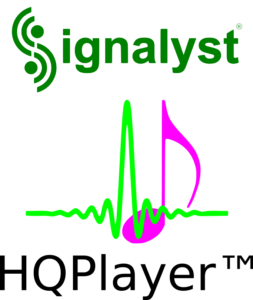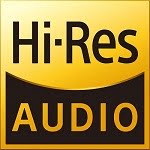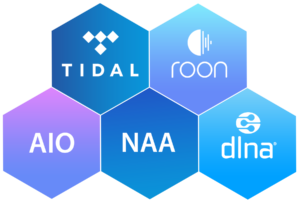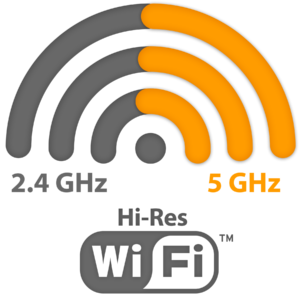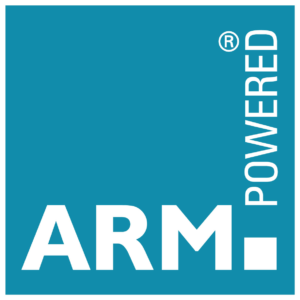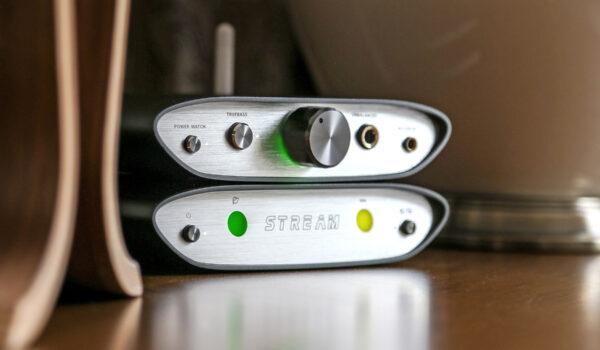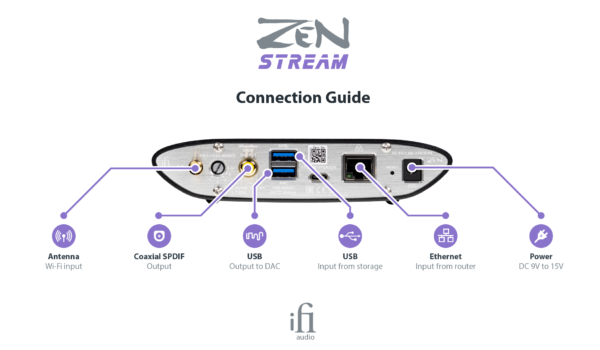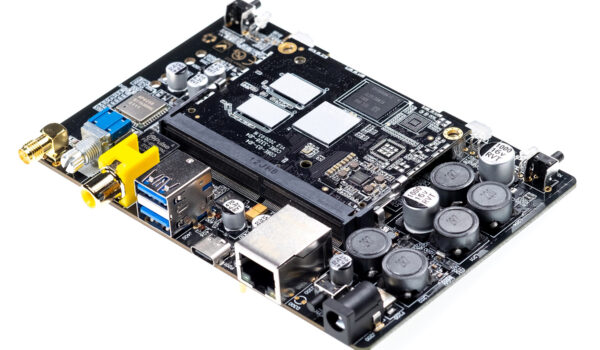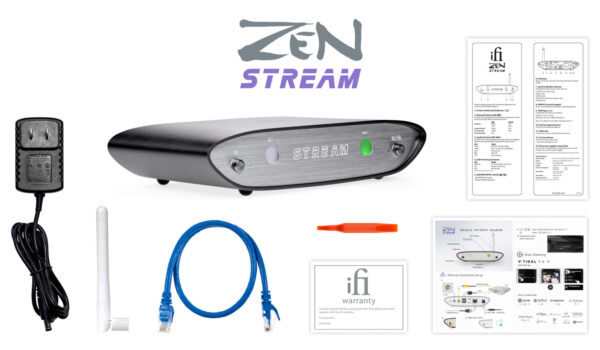Just add Remote Control
Beneath its classy exterior, the ZEN Stream is a technological streamer-de-force. It has one purpose – to send music simply from the Internet to your DAC with no loss of quality.
True hi-res performance of PCM384/DSD256 via WiFi/LAN. Just add your smart device as a remote and away you go.
Optimised open-source architecture – works with multiple dedicated platforms, completely and perfectly future-proofed as it is constantly updated.
Ease of use + audiophile implementation. Follow our simple set-up guides on YouTube. It is the bee’s knees of Streamers.
Check out what’s in the box here.

Warp speed tech
ZEN Stream is a true ground-up design by iFi — the hardware and software implementation is quite exceptional:
- Two SuperSpeed USB3.0 ports with Active Noise Cancellation II
- S/PDIF out with the iPurifier built-in
- iFi software developed with Volumio open-source as the starting point, then coded and optimised by us to achieve the purest streaming software bar none
These are some of the factors behind why the ZEN Stream is at the cutting-edge handling PCM384/DSD256 on LAN and WiFi (802.11n, with 100Mbps on 5Ghz).
‘Exclusive’ for your ears only
The ZEN Stream has one of the most fully-optimised software platforms in the world.
From the device’s drivers, to the kernel (the heart of the operating system), to the shell (which interfaces with the kernel), to the applications and the user interface — everything is fully optimised for seamless operation and excellent sonic performance.
An ingenious part of the ZEN Stream’s design is the ability to select between ‘Exclusive’ modes – individual settings dedicated to specific modes of operation to deliver the purest possible performance. All other programs are shut down – to minimise ‘software jitter’ — an often overlooked aspect that negatively impacts the quality of computer audio playback.
This ensures that the ZEN Stream is not merely a ‘jack of all trades’, but a master of all too.
- All-in-one (AIO) covers all modes
- ROON Ready
- Tidal streaming
- NAA streaming
- DLNA streaming
Please note software updates may take 2-3 minutes. Please do not disconnect your device.
Who’s who of Streaming
Hot off the press, the ZEN Stream has the following connectivity options:
- Stream straight from Spotify/Tidal apps with Spotify Connect and Tidal Connect
- Works with any DLNA certified streaming app
- Integrated Airplay 1 – easy streaming from Apple and Android devices
- Now ROON Ready
- NAA operation in conjunction with Sygnalist’s HQPlayer software
Scan the QR code here to download the Stream-iFi app. Set up your Wi-Fi connection and much more.
Tech savvy
Beneath the unassuming casework sits some serious horsepower in terms of both technologies and components:
- Powerful 64-bit quad-core ARM Cortex microprocessor
- USB and S/PDIF interfaces regulated by femto-precision GMT clock to eradicate jitter
- Active Noise Cancellation II and iPurifier technologies for USB and S/PDIF interfaces respectively
- Intelligent Ethernet switch controller
- High-PSRR, low idle current, low-dropout voltage regulators with soft start
- Synchronous 1.6MHz high-speed precision power supply controller
- C0G capacitors and Taiyo Yuden and Murata low ESR inductors
CONTENTS:
1 x ZEN Stream
1 x Ethernet cable
1 x Plastic screwdriver
1 x Power adapter
1 x Antenna
1 x User manual
1 x Instruction card
DACs convert digital information, stored or streamed by computers, into music we can hear through speakers or headphones.
Every device that’s a source of digital sound has a built-in DAC (TVs, games consoles, CD players, phones, portable music players etc). Dedicated external DACs sound much better than standard DACs used in digital devices such as phones.
Active Noise Cancellation (ANC) reduces unwanted sound by the addition of a second sound wave specifically designed to cancel out the first. This basically results in no sound at all as it reaches unwanted sound even at the lowest frequencies.
Passive noise cancellation is done by means of insulating filters and works best on the middle to high frequencies. It does not work on the lower frequencies meaning that some sound can still be heard.
MP3 – this is the most popular format, every device in the world can use it.
PCM – Pulse Code Modulation is the most common format for CDs and DVDs.
DSD – Direct Stream Digital is a very high-quality audio format, better than CD quality. The higher the number (sample rate), the better the recording – DSD64, 128, 256, 512 and 1024.
DXD – Digital eXtreme Definition is a very high-quality PCM format. It was developed to edit hi-res (high quality) recordings recorded in DSD.
DSD is a very high-quality digital audio format that’s even better than CD quality. The higher the ‘DSD rate’ – DSD64, 128, 256, 512 and 1024 – the greater the amount of music information available, which means better sound quality. Files can be remastered to higher file rates to improve sound quality. The pinnacle of this is DSD1024. Not many machines out there are capable of this feat, other than our Pro iDSD.
DLNA allows you to wirelessly send content from devices like laptops, tablets and smartphones to a compatible TV. It makes sharing media in the home simple.
DLNA stands for Digital Living Network Alliance. It was set up by Sony in 2003. Now used in a wide range of modern home entertainment devices, it allows videos, music and photos to be streamed and enjoyed on the big screen or a home cinema system quickly and easily.
A Network Audio Adapter (NAA) can convert audio signals to high-quality digital signals.
Regardless of the geographical distance, the digital signals can be transmitted simultaneously over the IP networks, such as LAN or Internet.
In electronic systems, power supply rejection ratio (PSRR) is a term widely used to describe the capability of an electronic circuit to suppress any power supply variations to its output signal.
Inductors have resistance inherent in the metal conductor, quoted as DCR in datasheets. This metallic resistance is small for small inductance values (typically below 1 Ω). It can be modelled as a resistor in series with the inductor, often leading to the DC resistance being referred to as the ESR.










